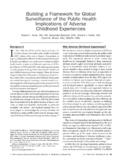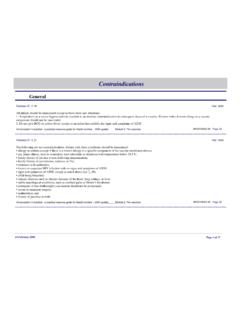Transcription of Dose–response and ghosting effects of an …
1 Dose response and ghosting effects of an amorphous silicon electronicportal imaging deviceL. N. McDermott, R. J. W. Louwe, Sonke, M. B. van Herk, and B. J. Mijnheera)The Netherlands Cancer Institute/Antoni van Leeuwenhoek Hospital, Department of Radiotherapy,Plesmanlaan 121, 1066 CX Amsterdam, The Netherlands~Received 3 October 2003; revised 13 November 2003; accepted for publication 13 November2003; published 23 January 2003!The purpose of this study was to investigate the dose response characteristics, including ghostingeffects, of an amorphous silicon-based electronic portal imaging device (a-Si EPID!
2 Under clinicalconditions. EPID measurements were performed using one prototype and two commerciala-Sidetectors on two linear accelerators: one with 4 and 6 MV and the other with 8 and 18 MV x-raybeams. First, the EPID signal and ionization chamber measurements in a mini-phantom werecompared to determine the amount of buildup required for EPID dosimetry. Subsequently, EPID signal characteristics were studied as a function of dose per pulse, pulse repetition frequency~PRF!and total dose, as well as the effects of ghosting . There was an over-response of the EPID signalcompared to the ionization chamber of up to 18%, with no additional buildup layer over an air gaprange of 10 to 60 cm.
3 The addition of a mm thick copper plate sufficiently reduced thisover-response to within 1% at clinically relevant patient detector air gaps (.40 cm) . The responseof the EPIDs varied by up to 8% over a large range of dose per pulse values, PRF values andnumber of monitor units. The EPID response showed an under-response at shorter beam times dueto ghosting effects , which depended on the number of exposure frames for a fixed frame acquisitionrate. With an appropriate build-up layer and corrections for dose per pulse, PRF and ghosting , thevariation in thea-Si EPID response can be reduced to well within61%.
4 2004 AmericanAssociation of Physicists in Medicine.@DOI: #Key words: portal dosimetry, amorphous silicon EPID, radiation dosimetry, dose response, flat-panel imagersI. INTRODUCTIONE lectronic portal imaging devices~EPIDs!were originallydesigned and developed for the purpose of geometric verifi-cation of patient set-up during treatment. However, their usehas been increasingly extended to also obtaining dosimetricinformation of the radiation treatment, either by pre-treatment verification or by means ofin vivodosimetry. De-spite the obvious advantages of an on-line, 2-D EPID dosim-etry system, extensive clinical use has been limited for anumber of reasons.
5 The use of EPIDs in the clinic for set-upverification is still limited worldwide, and there has beenlittle support from vendors to invest extensively in dosimet-ric applications. Verification of the dose in two or three di-mensions in the patient is complicated, which is especiallysignificant if portal dosimetry is to be used as an independentcheck of the treatment planning system. Furthermore, mostdepartments will have limited resources for the developmentof software required for portal are various possible approaches to portal is to calculate the dose at the plane of the detector be-hind the phantom or patient.
6 This usually requires develop-ment of in-house algorithms to predict the portal dose image~PDI!, since this option is not yet widely available in com-mercial treatment planning systems. An alternative approachis to take the PDI and predict the dose in a plane in thephantom or patient, since it is often more interesting to knowand verify the dose in the target volume than at the EPID plane. This approach has been applied using an algorithm toback-project the PDI to the mid-plane1 3or to reconstruct thepatient dose based on convolution/superposition methods,back-projecting the fluence measured with the of portal dosimetry have been reportedmainly for the type of EPIDs based on a liquid-filled~Li Fi!
7 Ionization chamber matrix,1 3,5 7the CCD camera-basedEPID8 13and a solid-state based studies com-pared the PDI with various combinations of film and ioniza-tion chamber measurements. The accuracy in dose predictionof 3% for most of these studies has usually been limited topoint doses on the central beam axis, low dose gradient re-gions and/or the use of homogeneous recently, amorphous silicon (a-Si!based EPID shave been developed with excellent image quality, relativelyhigh optical transfer efficiency, large imaging area and highresistance to radiation ,16 Moreover, the responseof thea-Si EPID has an excellent long-term signal reproduc-ibility of ~1SD!)
8 , as observed in our thea-Si EPID has also been extended to dose determina-tion in recent 21A reported advantage of thea-SiEPID is its linear dose response relationship, whereby asimple calibration factor may be applied to convert the EPID signal to the absolute dose. A number of these studies havereported a linear signal better than 1%, for various commer-cial types ofa-Si addition to quantifying the EPID dose response rela-285285 Med. Phys. 31 2 , February 20040094-2405 2004 31 2 285 11 $ 2004 Am. Assoc. Phys. , it is important to determine the amount of builduplayer required, as in any dosimetric system applied to highenergy photon beams.
9 EPIDs are typically designed todaywith an intrinsic 1 mm copper~Cu!plate covering the phos-phor layer, used to absorb low energy, scattered radiationwhich would otherwise reduce the image contrast. This Cuplate also provides some buildup to convert primary x-raysinto Compton reasons for using additionalbuildup material for portal dosimetry are~1!to ensure mea-surements are made beyond the dose maximum and~2!toattenuate scattered radiation from the patient. The latter isespecially relevant at small patient detector air gaps(,40 cm) , in which case the scatter contribution from theirradiated volume~of a phantom or patient!
10 To the EPID dosemay be ,24 Yeboah and Pistorius24investigatedthe dependence of the EPID dose response on scatter from aphantom using Monte Carlo calculations for a copper-phosphor portal imaging screen. They found a broad peak inthe photon spectra at low energies~50 100 keV!and ob-served a high sensitivity of the imager for low energy pho-tons. Previous authors have reported on the need for addi-tional buildup layer material such as polystyrene~PS!,19,25stainless steel12and Cu23,26for EPID dosimetry suggested by Partridgeet al.







